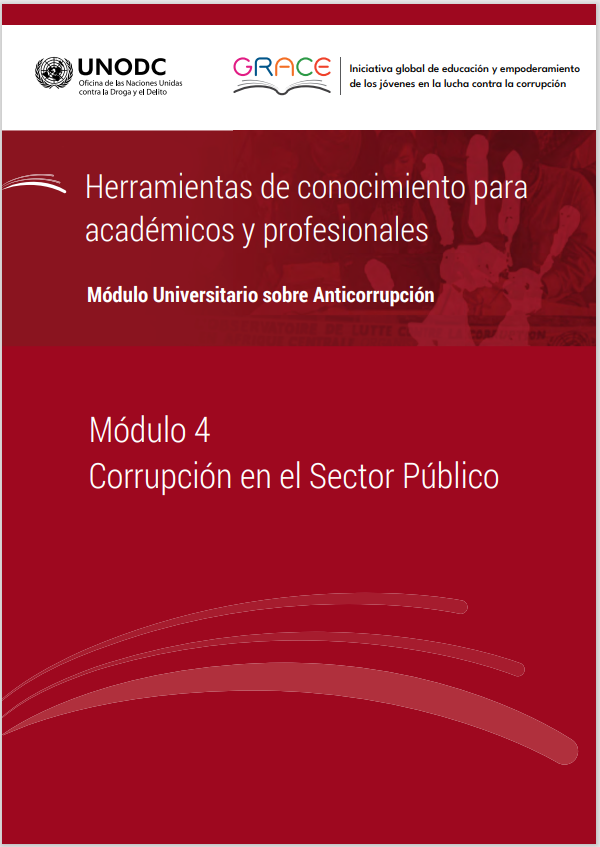Este módulo es un recurso para los catedráticos
Lecturas avanzadas
Se recomiendan las siguientes lecturas para estudiantes que estén interesados en explorar los temas de este módulo en más detalle y para los docentes que enseñan el módulo:
- Abbink, Klaus (1999). Staff Rotation: A Powerful Weapon Against Corruption?
- Ambe, Intaher, and Johanna Badenhorst-Weiss (2012). Procurement challenges in the South African public sector. Journal of Transport and Supply Chain Management, vol. 46, no. 1 (November), pp. 242-261.
- Anechiarico, Frank, and James Jacobs (1996). The pursuit of absolute integrity: how corruption control makes government ineffective. Chicago: University of Chicago Press.
- Arrowsmith, Sue, John Linarelli and Don Wallace Jr. (2000). Regulating Public Procurement: National and International Perspectives. The Hague: Kluwer Law.
- Asian Development Bank and Organisation for Economic Co-operation and Development (2008). Fighting Bribery in Public Procurement in Asia and the Pacific .
- Basu, Kaushik (2011). Why, for a Class of Bribes, the Act of Giving a Bribe should be Treated as Legal . New Delhi, India: Ministry of Finance.
- Bussell, Jennifer (2015). Typologies of Corruption: A pragmatic approach. In: Susan Rose-Ackerman and Paul Lagunes, eds. Greed, Corruption and the Modern State: Essays in Political Economy, London: Edward Elgar Publishing.
- Campos, Jose Edgardo, and Sanjay Kumar Pradhan, eds. (2007). The Many Faces of Corruption: Tracking Vulnerabilities at the Sector Level . Washington: The World Bank.
- Della Porta, Donatella, and Alberto Vannucci (1999). Corrupt Exchanges: Actors, Resources, and Mechanisms of Political Corruption. New Brunswick: Transaction Publishers.
- Fazekas, Mihály, István János Tóth, and Lawrence Peter King (2013). Corruption manual for beginners - "Corruption techniques" in public procurement with examples from Hungary. IEHAS Discussion Papers. Budapest: Hungarian Academy of Science.
- Federal Ministry of the Interior of Germany (2015). Preventing Corruption in federal administration: Annual Report 2015 . Berlin.
- Graycar, Adam, and Tim Prenzler (2013). Understanding and Preventing Corruption. Basingstoke, UK and New York: Palgrave Macmillan.
- Huberts, Leo (2014). The Integrity of Governance: What it is, What we Know, What is Done and Where to go. Basingstoke: Palgrave Macmillan.
- International Monetary Fund (2019). Fiscal Monitor: Curbing Corruption . Washington, DC.
- Leftwich, Adrian (2010). Beyond institutions: Rethinking the role of leaders, elites and coalitions in the institutional formation of developmental states and strategies. Forum for Development Studies, vol. 37, issue 1 (March), pp. 93-111.
- Leite, Carlos, and Jens Weidmann (1999). Does mother nature corrupt? Natural resources, corruption, and economic growth. Natural Resources, Corruption, and Economic Growth. IMF Working Papers Series. Washington DC: International Monetary Fund.
- Miller, Seamus (2018). Corruption. In: Edward N. Zalta, ed. The Stanford Encyclopedia of Philosophy, Center for the Study of Language and Information, Stanford Unviersity.
- Organisation for Economic Co-operation and Development (2008). Towards a Sound Integrity Framework: Instruments, Processes, Structures and Conditions for Implementation . Paris.
- Organisation for Economic Co-operation and Development (2017). Recommendations on Public Integrity . Paris.
- Organisation for Economic Co-operation and Development (2018). Behavioural Insights for Public Integrity: Harnessing the Human Factor to Counter Corruption. Paris.
- Philp, Mark (2017). Conceptualizing political corruption. In: Michael Johnston, ed. Political Corruption, Routledge.
- Power, Michael (2003). Evaluating the Audit Explosion . Law & Policy, vol. 25, issue 3 (July).
- Rodwin, Marc A. (1995). Medicine, Money, and Morals: physicians' conflicts of interest. Oxford University Press.
- Rose-Ackerman, Susan, and Bonnie J. Palifka (2016). Corruption and Government: Causes, Consequences, and Reform. Cambridge University Press.
- Rothstein, Bo (2011). The Quality of Government. Chicago and London: University of Chicago Press.
- Sachs, Jeffrey, and Andrew M. Warner (1997). Sources of Slow Growth in African Economies. Journal of African Economies, vol. 6, no. 3, pp. 335-376.
- Sartor, Michal A., and Paul W. Beamish (2019). Private Sector Corruption, Public Sector Corruption and the Organizational Structure of Foreign Subsidiaries. Journal of Business Ethics, pp. 1-20.
- Soudry, Ohad (2007). A Principal-Agent Analysis of Accountability in Public Procurement .
- Syed, Hussain Alatas (1990). Corruption: Its Nature, Causes and Functions. Avebury.
- Transparency International (2006). Handbook for Curbing Corruption in Public Procurement . Berlin.
- Transparency International (2007). Global Corruption Report 2007: Corruption in Judicial Systems . Cambridge University Press.
- Transparency International (2015). Transparency in Public Procurement. G20 Position Paper.
- Transparency International (2016). What is Grand Corruption and How Can We Stop It ? 26 September.
- Transparency International (2017). 10 Anti-Corruption Principles for State-Owned Enterprises . Berlin.
- United Nations Development Programme (2017). Tackling integrity risks in government contracts: an opportunity to unlock resources for sustainable development in Asia and the Pacific . Thailand.
- United Nations Office on Drugs and Crime (2013). Guidebook on anti-corruption in public procurement and the management of public finances - Good practices in ensuring compliance with article 9 of the United Nations Convention against Corruption . Vienna.
- Williams-Elegbe, Sope (2012). Fighting Corruption in Public Procurement: A Comparative Analysis of Disqualification or Debarment Measures. Oxford: Hart Publishing.
- World Bank (2000). Helping Countries Combat Corruption . Washington, DC.
- Yukins, Christopher (2011). A Versatile Prism: Assessing Procurement Law Through the Principal-Agent Model. Public Contract Law Journal, vol. 40, no. 1, pp.63-86.
 Siguiente: Evaluación del estudiante
Siguiente: Evaluación del estudiante
 Volver al inicio
Volver al inicio
